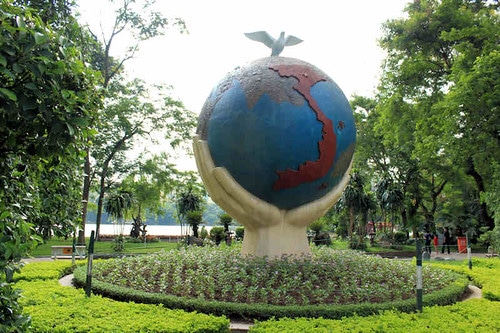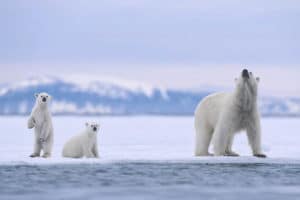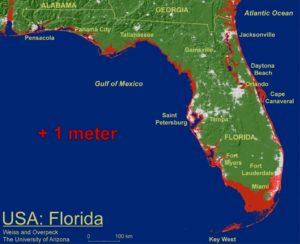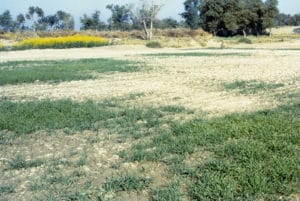
Views of Future Earth – Part III
by Usha Alexander
[This is the eighth in a series of essays, On Climate Truth and Fiction, in which I raise questions about environmental distress, the human experience, and storytelling. It first appeared on 3 Quarks Daily. This eighth essay is divided into four parts. The seventh essay in the series, called “Our Moment on Earth”, is here.]
Redrawing the Maps

The future world will be more barren than the one we’ve known, traveled by fewer animals, both in kind and in number. Fewer birds making a ruckus in the treetops. Dwindling herds of elk and moose, families of lemurs, orangutans, river dolphins, whales, and elephants. Fewer fireflies enchanting a summer night or ladybugs charming the afternoon. No more rhinos. No more polar bears. Every loss of an animal or plant species changes the local balance of life, further destabilizing its ecosystem. Similarly, when forests and meadowlands are fragmented into patches separated by fields or roads, the mix of animals and plants that live within them also changes. Thus, habitat fragmentation or local extinctions can kick off a trophic cascade that alters the very shape of the landscape, even the flow of rivers, the size of lakes, the pattern of rainfall. Due to fragmentation and climate change, the Amazon Rainforest is on the verge of converting to grass and scrubland, with untold consequences for regional weather patterns and agriculture that helps supply the western hemisphere.
Climate change is driving the northward expansion of the Sahara Desert to engulf all of North Africa, jump the Mediterranean Sea, and overtake southern Europe. In the Alps and other mountain ranges, receding glaciers will trigger avalanches and rockfalls, while the Ganga, the Rhine, and other glacier-fed rivers and lakes dwindle. As the familiar icy patch that once adorned the far north of every world map shrinks, the southern reaches of the northern boreal forest and peatlands will burn off, inviting a different mix of tress and grasses to creep northward and occupy the more temperate plains of the former tundra.

Kiribati, Maldives, and Micronesian states will be engulfed by rising seas. Thus, fewer far-flung islands will dot our maps, exchanged for far greater expanses of unbroken ocean. All the familiar shapes of the continents will take on new contours. Fine beaches from Florida to Maine will wash away, as coastlines everywhere are increasingly inundated and submerged, as hurricanes become more intense and destructive, tsunamis more powerful and lethal. Major cities, including New York, Mumbai, London, Jakarta, and Shanghai will migrate or shrink as decades of steady sea level rise – or a more rapid rise from the loss of the West Antarctic ice shelf – make them increasingly vulnerable to storm surges and tides. So too with long stretches along the coasts of eastern England and northern Europe.
Ways of life or infrastructures built with the expectation of predictable seasonal cycles or climatic conditions will suffer and people will migrate. Nigeria is one region already feeling this, as rain patterns change and deadly conflicts erupt over dwindling water. Globally, conflicts over water have more than quadrupled over the past thirty years. Syria has disintegrated into a failed state, partly triggered by lingering drought that fueled internal migration and political conflict; Central America’s emigration crisis largely results from changed weather patterns. In both cases, the changing climate eroded the agricultural basis of local livelihoods and communities, sparking unrest and violence (though much news reporting elides the climatic causes). Meanwhile, tens of millions of people in southern China and the montane regions of south-central Europe are reeling from the home-wrecking deluges that will continue to plague cities into the future.

As seasons alter their timing and character, longstanding agricultural centers around the world will wither while new regions spring up. Hotter summers, warmer winters, drought, melting glaciers, and extreme weather already adversely affect the cultivation of strawberries, fruits, nuts, wine, chocolate, coffee, and other everyday foods. The world’s breadbaskets will relocate – or cease to exist – due to changing rainfall, heat, and extreme weather, such as is already squeezing agricultural production in Australia. In just the past year, the United Kingdom, Poland, Romania, Turkey, Pakistan, China, India, Brazil, and the United States, among other nations, have suffered significant crop damage or reductions in yield due to weather or climate. To make matters worse, the rising concentration of atmospheric carbon dioxide is decreasing the protein, iron, zinc, and other essential nutrients in plant foods, making agricultural produce less nutritious. However far-fetched it may seem now, the UN warns that mounting losses to agriculture will increase risks of widespread malnutrition and famine on scales we haven’t seen in half a century, as anticipated this year in Nigeria. Heat waves will intensify to such a degree in some parts of the world – including western and southern Asia – that some currently populated regions may be rendered unsuitable for human settlement. Rising heat in India is already costing tens of billions of hours in lost labor each year, while chronic heat stress is causing a growing epidemic of premature death by kidney failure among farm laborers in India and Central America.
[End of Part III]
[Views of Future Earth – Part IV ]

Usha Alexander was born to Indian immigrants who came to the United States in the 1950s and settled in the very small town of Pocatello, Idaho. She ran away to university at the age of 19, and later joined the US Peace Corps, where she served as a science teacher in the archipelago nation of Vanuatu. In the late 90s, Usha made her way to the San Francisco Bay Area of California, where she settled and worked for Apple Computer for many years.
Since 2013, Usha resides with her partner, writer and photographer, Namit Arora, in the National Capital Region of India. Usha has lived in four different countries and has learned to carry her home within herself, yet she frequently returns to the CA Bay Area with a certain sense of homecoming.